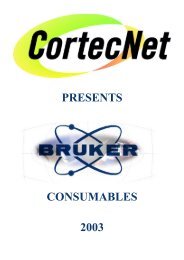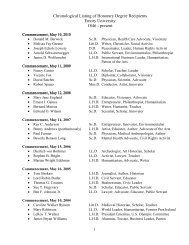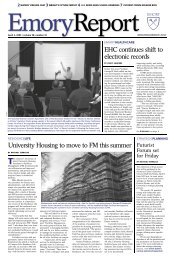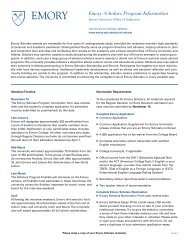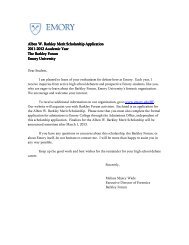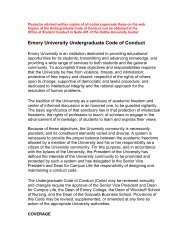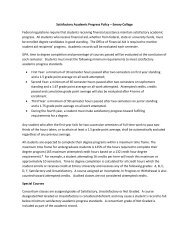DOSY Experiments - Emory University
DOSY Experiments - Emory University
DOSY Experiments - Emory University
Create successful ePaper yourself
Turn your PDF publications into a flip-book with our unique Google optimized e-Paper software.
Probespinmax 3000 / 10000*<br />
(* mas and 10000 1/s will be the options for the newly released FastNano TM probe)<br />
corresponding to VnmrJ parameters probetype, spintype, and spinmax. The first one,<br />
probetype, is a new global parameter. While the addprobe macro adds this new parameter to<br />
the probe file (with a default value of liquids), the updateprobe macro will add that definition to<br />
an existing probe file if it is not present yet. Alternatively, an existing probe file may be edited,<br />
adding the first of these three lines exactly as shown above. The other two parameters,<br />
spintype and spinmax, do exist since VnmrJ 2.2C and are only relevant for systems with<br />
software spin control. Upon changing to a Nano Probe, all three parameters are activated (via the<br />
_probe macro) and the system is ready to do the extra, Nano Probe related tasks automatically.<br />
2.3.1 User created <strong>DOSY</strong> pulse sequences<br />
This software setup requires a few changes to existing pulse sequences: the actual gradient<br />
adjustment takes place within the pulse sequence itself, i.e., is performed at “go” time (through<br />
the "Acquire" button or the cpgo macro). It is therefore the pulse sequence programmers privilege<br />
and responsibility to ensure that the pulse sequence is Nano Probe compliant.<br />
All <strong>DOSY</strong> pulse sequences in VnmrJ3.0 have been adjusted to be compliant with Nano Probes. A<br />
user created diffusion pulse sequence could be made Nano Probe compatible by following the<br />
steps listed below:<br />
1. Be sure that the probe file has all relevant parameters defined and set, as outlined above.<br />
Include the necessary changes in your pulse sequence code as described below and<br />
recompile the pulse sequence.<br />
2. Making an existing gradient pulse sequence compatible with Nano Probes involves<br />
several changes in the pulse sequence code itself:<br />
Near the top of the pulse sequence, just below the line<br />
#include <br />
an extra include line must be added for the header file chempack.h:<br />
#include <br />
Define which parameter(s) need adjustment by inserting expression "A" (or "A" and "B"<br />
together) from below. Note that a homospoil gradient pulse (i.e., a gradient that simply<br />
destroys residual transverse magnetization) does not need this type of adjustment. Let's<br />
assume that the relevant gradient pulse has duration of gtE and amplitude of gzlvlE. In<br />
this case, expression "A"<br />
gtE = syncGradTime("gtE","gzlvlE",1.0) trims the gradient pulse length<br />
gtE and leaves the amplitude gzlvlE unchanged. Each Nano Probe compatible<br />
pulse sequence must contain at least this definition. The third argument is a multiplier<br />
that is typically set to 1.0 in sequences with single gradient pulse duration. If a pulse<br />
sequence uses gradient pulses with lengths of both gtE and gtE/2 (as many<br />
heteronuclear Chempack-type sequences), then the multiplier must be set to 0.5 to<br />
ensure that the requirements are also met for gtE/2.<br />
A second expression "B"<br />
gzlvlE = syncGradLvl("gtE","gzlvlE",1.0)<br />
used with a combination with expression "A" above adjusts also the gradient<br />
amplitude (gzlvlE in this example) such that the gradient area (i.e., the product<br />
gtE*gzlvlE) remains constant.<br />
10




